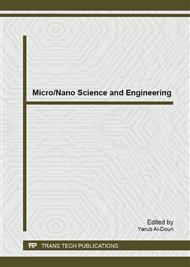p.308
p.313
p.318
p.323
p.329
p.334
p.339
p.344
p.349
Effects of Ageing Time of ZnO Sol on Properties of ZnO Films by Sol Gel Spin Coating
Abstract:
In recent years, there are many techniques developed to synthesize zinc oxide (ZnO) films. However, among the synthesis methods available, sol-gel has the most advantageous which offers cost effective features. In the present work, ZnO films were prepared by solgel spin coating technique. The effects of solution ageing times which varies at 2h 15 min, 3h 30 min and 24h were investigated. The structural, morphological and optical properties were studied using an x-ray diffractometer (XRD, Bruker D8 Advance), atomic force microscope (AFM, Tenko XE-100) and ultra violet-visible spectrophotometer (UV-Vis, Shimadzu UV 1800), respectively. Based on the XRD measurement, it was revealed that ZnO films were polycrystalline with hexagonal wurtzite structure. The crystallite size is in the range of 34.4 ~ 28 nm which decreased with ageing time increment. On the other hand, the AFM analysis revealed that the surface roughness of the films increased due to the increment of ageing times. Optical transmittance spectra indicate that all films were transparent (>75%) in the visible range which slightly improved with increasing of ageing times. The optical band gap was estimated to be around 3.24 ~3.26 eV using Taucs plot. We revealed that the ageing time of ZnO sol influenced the material properties of ZnO films. Based on our finding we proposed that 24h ageing time is optimum for the fabrication of high quality ZnO films.
Info:
Periodical:
Pages:
329-333
Citation:
Online since:
April 2014
Keywords:
Price:
Сopyright:
© 2014 Trans Tech Publications Ltd. All Rights Reserved
Share:
Citation:


